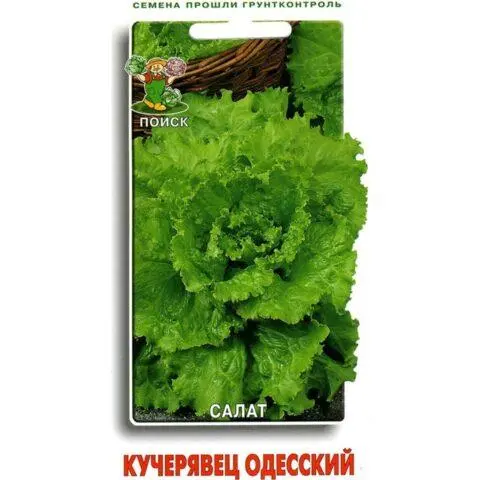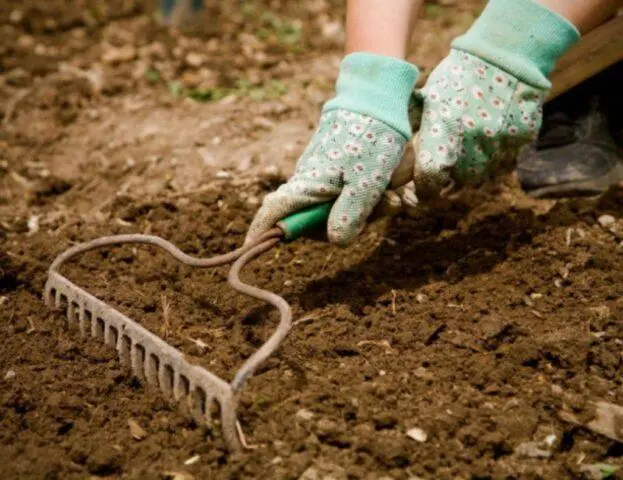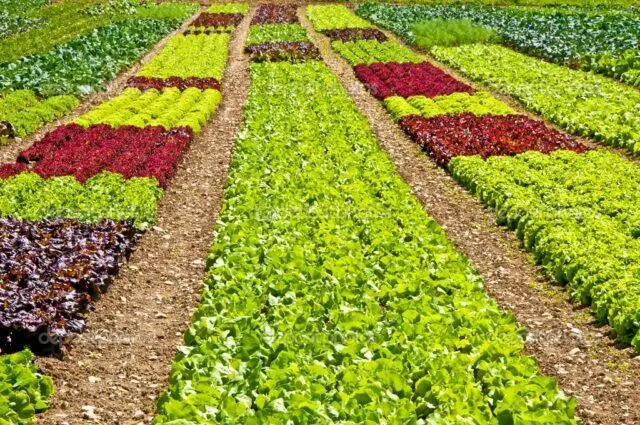Contents
- Description of lettuce varieties Kucheryavets Odessa
- Advantages and disadvantages
- Growing lettuce Kucheryavets Odessa from seeds in open ground
- Growing lettuce Kucheryavets Odessa on the windowsill
- Useful properties of salad Kucheryavets Odessa
- Application
- Conclusion
- Reviews about the salad Kucheryavets Odessa
Lettuce Kucheryavets Odessa received at the state agricultural station in Odessa. The variety is recommended for cultivation in the Central and West Siberian regions, the North-West. Entered into the State Register in 1957.
Description of lettuce varieties Kucheryavets Odessa
The culture is classified as head of cabbage. It is recommended to grow it in open ground and in film greenhouses. Skilled gardeners have learned how to get a crop when sowing material in seedling boxes.

One of the characteristic features of Odessa Kucheryavets lettuce is resistance to coloring.
Rosette with leaves of medium or large size, reaches 24-32 cm in diameter. The plates are semi-raised, collected in a loose head. The mass of each can reach 190-206 g.
The leaves of the lettuce Kucheryavets Odessa are whole-edged, fan-shaped in shape, light green in color. The surface of the plate is alternately swollen and depressed, not gathered to the center. The edges of the leaves are finely curly and double-toothed. Salad Kucheryavets Odessa tastes crispy, slightly rough, but juicy.
The variety of greens belongs to the medium-late. From the appearance of seedlings to the collection of heads of cabbage, an average of 68-75 days pass. The yield of the Kucheryavets variety is 1-2,7 kg per 1 m2. The greens are perfectly stored, tolerate transportation well.
Advantages and disadvantages
Most gardeners note the attractive appearance of greenery. It can be used not only to add to food, but also to decorate the site.

Salad Kucheryavets Odessa has high taste qualities: leaves without bitterness, juicy and tender, go well with other vegetables
Advantages:
- rapid head growth;
- strong immunity;
- the possibility of sowing material all year round;
- frost resistance;
- good keeping quality and transportability.
No culture deficiencies were identified.
Growing lettuce Kucheryavets Odessa from seeds in open ground
You can cultivate the variety both in the garden and in the greenhouse. And if there is a window sill, fresh greenery is easy to get in winter. The choice of planting method depends on the personal preferences of the gardener.
When to plant lettuce Kucheryavets Odessa
Since the variety is not afraid of short-term frosts, all work can begin as soon as the soil warms up. In most regions, this period occurs in April-May. In order for the greens to be available all year round, the crop should be sown constantly, with an interval of two weeks. Winter sowing is also possible.
Preparation of beds
When placing greenery on the site, it should be borne in mind that the Kucheryavets Odessa variety prefers scattered sunlight. When the light is too bright, the plant produces flower stalks.
The soil for the garden bed should be enriched with organic matter. Since autumn, fertilizer must be applied to the soil: a bucket for each m2. It is recommended to use a neutral in acidity, but porous substrate.

A bed for lettuce Kucheryavets Odessa does not need to be dug up, it is enough to loosen it using a chopper or rake
Landing technology
The initial stage of work with lettuce Kucheryavets Odessa is the disinfection of seeds. To do this, they need to be immersed in a solution of manganese for 15 minutes. At the end of the procedure, the seeds must be well washed and dried.
In the garden, form furrows with an interval of 20 cm. Deepen the seeds 1-2 cm into the ground, lightly sprinkle with earth. You can scatter the material thickly: after the emergence of seedlings, you will need to thin them out, leaving the largest specimens.
Caring for the Kucheryavets Odessa variety consists in weeding, loosening and watering. Weeds should be removed in a timely manner so that plants do not compete for nutrients in the soil.

The lettuce is harvested as the heads are formed: you need to carefully cut the greens and rinse it well before use
There is a planting option before winter. In this case, the algorithm is the same, but with a few nuances. After sowing, the bed should not be watered. It needs to be tightly mulched. In the spring, after the snow melts, the first shoots will appear. They will need to be thinned out, watered abundantly.
Growing lettuce Kucheryavets Odessa on the windowsill
You can make up for the lack of vitamins in winter if you cultivate lettuce at home. The algorithm itself is simple:
- Prepare a planting container: pot, box or plastic container. The main selection criterion is the height of the sides more than 10 cm.
- Prepare the substrate by mixing humus with sand and earth from the garden in equal proportions. Crushed stone or broken brick can be used as drainage.
- Fill the container by ¾, level the ground in it, make depressions in the soil with an interval of 2-3 cm. Place 1-2 seeds in the furrow. Top with earth, pour plenty of water.
To grow lettuce Kucheryavets Odessa, you need to ensure that the temperature in the room is not lower than +20 ° C. Watering is carried out as needed. Weeds must be removed in a timely manner, mold should not be allowed to appear. All damaged heads are recommended to be removed in a timely manner. If you plan to grow a crop all winter, then you should not forget about fertilizing the soil.
Useful properties of salad Kucheryavets Odessa
Greens contain a large amount of mineral salts. Salad is rich in iron, so it is recommended to include it in the menu for anemia. Calcium, phosphorus and sulfur are no less important for the human body. Zinc, cobalt and copper contained in the leaves are known for their antioxidant action. And soft dietary fibers contribute to the normalization of bowel function. With the help of Kucheryavets Odessa salad, you can make up for the deficiency of vitamins PP, A and C.
Application
The method of using greens is simple: they should be consumed fresh. Can be added to salads, eaten with meat dishes and side dishes. The greens should not be subjected to heat treatment, it should be washed well enough. As a salad dressing, you can use mayonnaise, sour cream with mustard, olive oil. You need to eat the dish immediately, it cannot be stored.
Conclusion
Lettuce Kucheryavets Odessa is a popular leafy green. The culture can be grown year-round: in open ground, in a greenhouse or on a windowsill. The plant is undemanding to care, high-yielding, responsive to watering.









